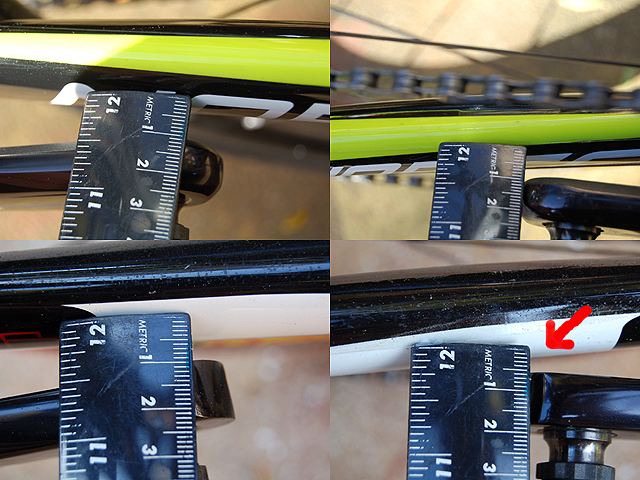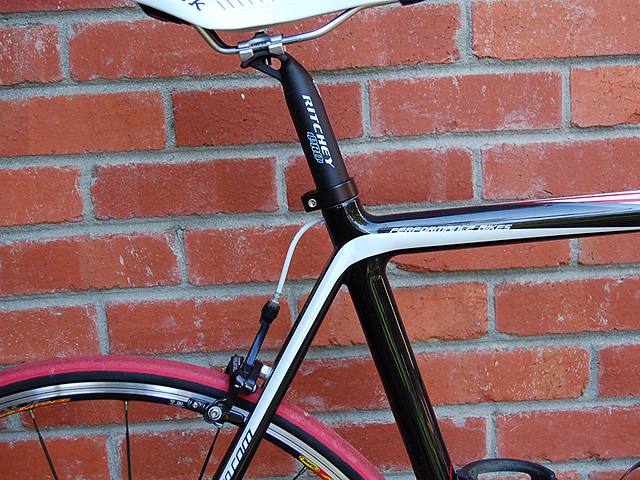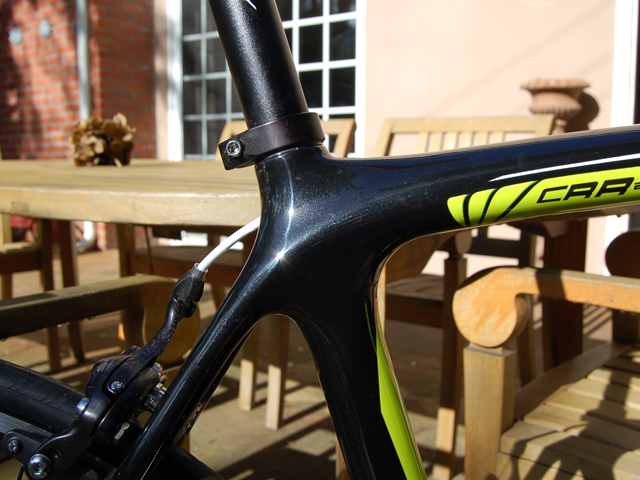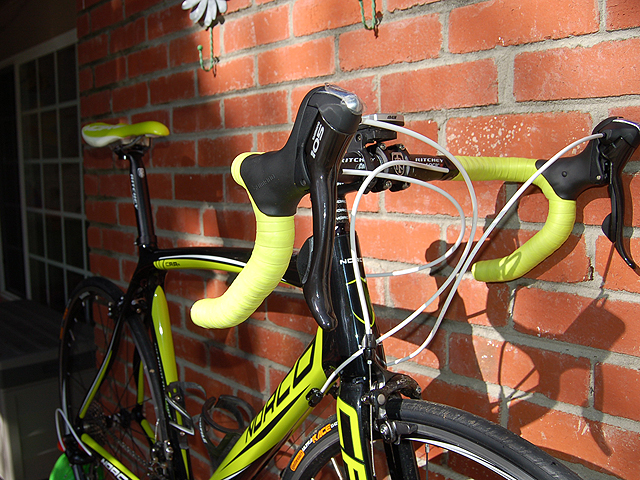Tested 12/13/09 and 1/31/2010

- Size: 58 cm, frame weight 1790 grams (claimed)
- SRAM Rival drivetrain + Force rear derailleur
- Ritchey Pro Logic handlebar, Pro 4-Axis stem, Ritchey Pro 2-bolt seat post
- Mavic Aksium Black wheels (1795 total grams)
- 11-25 rear cassette/compact 50/34 S550 crank (825 grams)
- Vittoria Zaffiro Pro II 700x23 clincher tires (240 grams)
- Fizik Arione white saddle
- White bar tape, cables, seat, and brake covers
- MSRP: $3,236 USD
- 17lb 14oz with Look Keo Carbon Ti pedals

- Size: 56 cm, frame weight 1740 grams (claimed)
- Shimano 105 drivetrain
- Ritchey Comp Logic II handlebar, Comp stem, Ritchey Comp 2-bolt seat post
- Shimano WH-RS10 black wheels (1900 total grams)
- 12-27 rear cassette/standard 53/39 FSA Gossamer crank (860 grams)
- Continental Ultra Race 700x23 clincher tires (220 grams)
- Norco brand saddle
- Chartreuse bar tape, cables, and seat
- MSRP: $2550 USD
- 19 lb 4oz with Look Keo Carbon Ti pedals
SRAM Rival d
Overview
Norco is more known for it's mountain bikes where they offer an
astounding 50 different models. They've been making bikes in Canada for over 40
years, and they are branching out into the road bike arena. For 2010, they offer
4 road race bikes, all based on the essentially the same frame but with varying
component levels. Norco touts three main differentiators for their carbon road
frames:
1. EPS Mandrel system "process". This offers a much stronger and more controlled surface when laying up the carbon in complicated and high stress areas of the frame such as the head tube and BB shell connections. This process eliminates the chance of wrinkling inside the layup or cracking in these areas of the frame thus greatly improving the strength compared to conventional mandrels.
2. HTR- High Toughness Resin is used in all 2010 Norco carbon frames. It is a newly developed resin that is exclusive to our carbon manufacturer. The HTR resin increases the impact resistance by 20% making the frames less prone to damage. It also decreases the amount of resin required and therefore decreases the overall weight of the frame.
3. Thermoplastic Resin. Another new feature that Norco carbon frames feature for 2010 is the use of a thermo plastic mesh laminate in key stress areas inside the frame. This smoothes out THE carbon layering and disperses stress forces WHICH prevents the propagation of small cracks. This new mesh system is designed to work in conjunction with the EPS process.
 Bike
1: 2009 CRR-2 MSRP: $3,236, 17lb 14oz
Bike
1: 2009 CRR-2 MSRP: $3,236, 17lb 14oz
We originally tested a 2009 CRR-2. It arrived almost fully built in the bike box.
Unwrapping was an amazing origami-like treat. Most of the components were already
installed and the package was intricately wrapped. They thoughtfully included
black and white touch-up paint, required reflectors, and even a bell. Norco makes it easy for
dealers to get their rides up and running! All I needed to install the wheels, front
brake, handlebars, and seat post--even the bar tape was installed. The bike was
pretty much dialed as is, though I needed to spend some time with the rear
derailleur; it needed some adjustment and the cable was too tight. Ironically,
despite the excellent packaging; the handlebar must have slammed the head tube
in transit; the clear coat and epoxy had a noticeable dent. Shame.
The bike looks fantastic with matching Ritchey cockpit and white brake hoods, sweet white jagwire cables, and comfy white Arione saddle with bright red Zaffiro tires to really make the looks pop. Componentry was good as well with excellent SRAM Rival throughout with a bonus SRAM Force rear derailleur. Wheels are extremely stiff (though heavy at 830 front/965 rear/1795 total grams) Mavic Aksiums. Of course, though the white looks great, it is dirt prone and after a short 20 mile ride to work, the seat was got dirty, though Windex cleaned it right up.
Performance
The frame features oversize tubes and a massive bottom bracket, very
similar in design to the vaunted Cervelo R3. The bike feels exceptionally solid
and is virtually silent. It's remarkable how sturdy it felt compared to my main
bike, a sub 14 pound Cervelo R3. Shifting was solid and smooth, and perhaps because it
contained the whole SRAM Rival gruppo, it felt even better than the SRAM Red/Easton
EC90 setup I normally run. Out on the road, the gruppo worked well with one
exception; the right shift lever would "catch" on the handlebar under
braking. I didn't fiddle
with the location and reach to try and solve for it, but it was annoying.
The bike features a somewhat high front end which should make it comfortable for most riders though not as aggressive as other pure road racers. At 58cm, the bike was a size larger than what I'm used to, and the 110mm stem was a big reach. I moved the stem down on it's spacers and scooted the saddle forward to compensate, but it was still a bit of a stretch. The compact gearing with smart 11-25 rear cogset was versatile, though if I owned it, I'd replace the front compact 50 toother with a 52 and bump the 34 with a 36.
Out on the road, the bike was remarkably smooth and quiet. On most surfaces, there is gentle feedback from the road; it is pretty much unflappable except on rough roads where it clatters a bit. The frame is incredibly stiff out of the saddle; it encouraged out-of-the-saddle sprints and standing just for the fun of it. There is a time trial course nearby that features a moderate hill in the middle; my goal is to always try to maintain 20mph through the crest. I was amazed with Norco; I hit the climb at 27, held 24 for most of it, and exited at 22mph. I've never really believed the saying that "heavy wheels take a while to spin up but once at speed, hold it"--maybe this is true. Handling-wise, it's very stable though maybe a bit conservative in the turns. But rock-steady on descents. Finally, after a cold 65 mile ride, I didn't feel physically fatigued or beat up. Very impressive.
 Areas
of improvement
Areas
of improvement
As stated, the right shifter would stick to the handlebar on heavy braking;
this could probably be fixed with some fine tuning. Additionally, the dented
head tube was a real bummer caused by rough shipping & handling. But there was
one real problem that stood out. The clearance between the crank arms and the
chainstays varied greatly. On the driveside, it was about 6mm while the left
side was 10mm. I did notice my right heel occasionally scraping the chainstay as
a result.
Weight and Value
The CRR2 offers a great component set for the price. In the eighties
and before, a 20lb bike was something of a miracle. Interesting how times have
changed, and at 17lbs, 14oz, it might even be called heavy. Though it's not a featherweight
it does have a great foundation with the fundamentally light frame and fork and
light SRAM drivetrain. This means it's a great platform to upgrade with time.


2010 Model Line changes
For 2010, Norco has spec'd the CRR-2 with an eye toward value at an
amazing $2,550 though with a heavier component set. One model up, the CRR-1
offers the same SRAM Rival/Force components of the '09 CRR-2 plus an integrated
seatpost and excellent 16lb 5oz weight for $3699.
 Bike
2: 2010 CRR-2 MSRP: $2,550, 19lb 4oz
Bike
2: 2010 CRR-2 MSRP: $2,550, 19lb 4oz
Nocro later sent the 2010 model CRR-2 to compare to the '09. The bike
was similarly stunning to the 2009 model with lime green decals and integrated
green saddle, cables, and bar tape. Though the saddle was generic, it proved to
be surprisingly comfortable. This was also a 56cm which fit me a lot better so I
didn't have to fiddle with the seat or stem. More importantly, the new model is
a whopping $686 less expensive and the frame features more elegant
sweeping seatstays (very reminiscent of a Look 595), slightly lighter frame
weight, and a tapered 1 1/4" to 1 1/8" fork. Sure enough, the front end
felt stiffer, provided more feedback and it seemed to turn better. Yet overall,
the ride was more damped and compliant, especially over
chatter. Like the previous model, the stiff platform felt solid while climbing.
They also "fixed" the discrepancy between the crankarms and chainstays; the
distance was the same 10mm on each side.
But to the dollars saved have a cost in the form of weight. The 2010 was a hefty 19lbs 4ounces. The new model uses a step lower cockpit from Ritchey, 105 components, FSA Gossamer crank, Shimano wheels, and wire-beaded tires that add a whopping 600+ grams (21 ounces) of weight.
Unfortunately, the heavy componentry took a toll on the riding experience. The heavier wheels were noticeably sluggish and I didn't have the same sensation of maintaining speed. And though the frame is very stiff and efficient, it felt relatively slower on the flats and while climbing. On my benchmark climb, the famous Old La Honda road, I hammered up it, averaging 174 bpm heart rate; I thought it was a 21:00 effort. Yet my time was 60 seconds slower. So the weight was significant. I also preferred the '09's gearing. It has a 50/34 x11-25. The '10 had 53x39 x 12-27. The 50x11 is bigger than the 53x12 while the 34x25 is lower than the 39x27.
Despite the additional weight, I have to say Shimano 105 shifters are simply superb. Shimano touts their "light action" and I couldn't agree more. Unlike the new Ultegra and Dura Ace models, 105 still has external shift cables. This helps reduce friction. And sure enough, the shifting was effortless and far smoother than the SRAM Rival or Red.
Summary
Norco has done a great job with this foray into the road cycling
market. They offer a solid component selection and outstanding "customized"
finish work with the matching cables, saddle, decals, and bar tape. The lighter
weight '09 was better for climbing but both felt extremely confident on the
descents. Both offer a lot for the
money and they are damn cool looking. Most importantly, Norco provides a "future proof" platform
with with a light frame and fork which will be fun and rewarding
to upgrade as your skills develop.
If you are looking for an a solid road race bike that's a great value for the money, Norco is a really impressive choice.
Value: 4.5 stars
Overall: 4.25 stars





